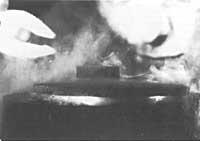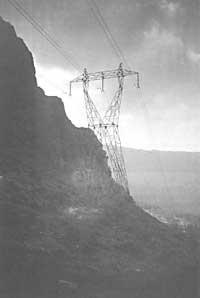Superconductors. With expectations frozen?
From cold to heat

Physicists have long known that at a temperature close to absolute zero (-273°C) the electrical resistance of some materials disappears. Liquid helium, whose melting temperature is -269 °C, has been used to analyze this phenomenon. In the field of medicine and other fields a few sessions were held with the aim of developing the industrial application of superconductors, but enormous difficulties had to be overcome. Working at these temperatures is expensive on the one hand and technical problems on the other.
In 1986 the picture changed a lot. At the IBM research center in Zürich, George Bednorz and Alex Müler obtained a superconducting ceramic material at -238°C. Thanks to this, in 1987 they were awarded the Nobel Prize in Physics.
This discovery led physicists to seek fires and flames for high temperature superconductivity worldwide. There have been numerous symposiums and meetings on this subject, but undoubtedly the most important is the one held on March 18, 1987 by the association of American physicists. At a New York hotel nearly 4,000 physicists gathered, surrounded by photographers, TV cameras and journalists. There it was declared that superconductivity exceeded the limit of liquid nitrogen, which was -196°C.
Then great hopes arose and everyone began to dream. As they believed that the superconductivity at room temperature would be reached the next day, the electrical energy accumulated in large quantities, the electric transport without losses, the superfast computers, etc. anywhere. They all announced a world ruled by superconductors.
Three years later, however, the warmers of then are temperate and despite the research carried out in ceramic superconductors, the temperature mark has only reached -148°C. Recently, at the University of Detroit, J. T. Physicist Txen has prepared a superconductor material at -23°C, but the new one has not been confirmed. Therefore, superconductivity at room temperature seems to be quite far away.
Liquid nitrogen technology
Meanwhile, many people have begun to develop liquid nitrogen technology, as the passage of superconductivity from liquid helium temperature to liquid nitrogen temperature has greatly facilitated things. Liquid helium is expensive and difficult to use, requires complicated installations. Liquid nitrogen, on the other hand, is forty times cheaper, with a yield 30 times higher than that of the terrace and helium. However, in laboratories researchers are working hard to achieve higher temperatures for superconductivity. Therefore, it does not mean that scientists are standing.
From an industrial point of view, work is sufficient if other problems arise in applications regardless of temperature are solved. New “high temperature” materials have some drawbacks. Although chemicals easily manufacture them in the form of crystalline mass, their usefulness for applications is very low. That is why many public and private laboratories are working to adapt these materials to industrial applications.
Superconductivity in electronics
The rapid transmission of signals is increasingly interesting in electrical circuits. Silicon and gallium arsenide have made great strides in this field and currently a square chip of one centimeter in length has a response time of 100 picoseconds (100 x 10 -12 seconds). However, the response time in all electronic circuits is ten times higher due to the large number of existing connections. Each connection, however small it may be, has an electrical resistance and is usually in series, so that among all they decrease the speed of circulation of signals. On the other hand, the Joule effect also produces heat in the connections, which is detrimental to its operation.
Faster logic circuits would reduce response time to a picosecond, but high temperature superconductors would be needed. In these hybrid circuits the logical part of connection, formed by semiconductive memories, would be formed by superconductors, all refrigerated by liquid nitrogen.

But before industrialists must master thin layer technology. In America, Japan and Europe, progress is fast. In Europe, for example, very fine superconductive layers have been obtained in the siliceous support of cathodic fracture, ultrarrapid evaporation or laser ablation precipitation, of a hundred etilngström (1 Á = =10 -10 m).
However, if you want to introduce new components in the world of electronics you have to discard some current materials, which is difficult because large companies have made large investments in silicon technology.
Superconductivity in magnetism
Another interesting field of application of superconductivity is magnetism. Today, for example, for medical diagnostics or electrical power generation, strong magnetic fields are needed. These magnetic fields are generated in large electromagnets in which there are conductive threads that cross the electric current. To avoid the obstacle of electrical resistance of copper wires it is necessary to use large diameter wires. Therefore, the coils have no choice but to be large in size and they consume a lot of energy.
Superconductors are the right way to solve these problems, but so far the use of liquid helium has limited things a lot. ALEPH particle detector, LEP particle accelerator (from CERN Geneva), magnetic-nuclear resonance medicine technologies, etc. manufactured with helium-cooled superconductive coils. These coils are made of niobium and titanium alloys, since at low temperatures these metals are superconductors. But it is difficult to form a thread to ceramic superconductors. However, it seems that the Japanese have made considerable progress in their research and may soon be able to manufacture ceramic superconductor threads. In this way, the high temperature superconductivity will open the doors of entry to the industry.
The military is also very attentive to superconductivity in the field of liquid nitrogen. Liquid helium cannot be used by plane due to storage and operation problems during flight. Liquid nitrogen, on the other hand, is already used by plane to cool infrared detection cameras.
Energy storage
Another problem that superconductors can solve is the storage of electrical energy in large quantities. In America and Germany there are scientists working on projects to develop this field.
Basically it is intended that a large amount of energy is stored in a coil without any loss, and then used slowly depending on the needs. In cities, for example, when consumption is greatly reduced at night, energy would accumulate in superconducting coils and when consumption increases during the day the coil would be discharged.
On the other hand, the military wants this kind of coils for the “star war.” This is because in 100 seconds between 0.4 and 1 gigawatt of energy would be emitted (1 gigawatt = 10 9 watts).
However, high temperature superconductors, like those of cold temperature, have their limits. If the so-called “critical current” level passes, the material ceases to be superconducting and shows the behavior of any normal driver. Cold superconductors of niovio alloys, for example, present critical current levels at -269°C in 10 million amps per square centimeter and in current high-temperature oxide superconductors, the level is one hundred times lower than ten.
Electricity transport

These materials, lacking electrical resistance, would transport the electric current over long distances without loss. The Joule effect causes transport lines to lose between 10 and 15% of energy converted into heat.
For the realization of superconductor lines, however, the cooling system should be installed all the way and its cost is for the moment incalculable. In this line, there could also be significant risks. If any point in the line was warmed by a cooling system failure, lightning failure or other causes, it would cease to be superconductive immediately. Therefore, this heat would be heated and transmitted to the environment, finally affecting the entire transport network.
Magnetic train
The magnetic levitation train project is one of the most interesting projects of recent times. The train is based on the repulsion force that interacts two identical magnetic poles. The magnetic field, therefore, must be large enough to raise the soil weight in hundreds of tons. This can only be achieved by superconductor coils. Japanese and Germans are the ones who have so far carried out magnetic train tests. For this purpose they have used liquid helium.
The train has no wheels and moves in the air without touching land. Therefore, they cannot be used on normal rail tracks. Therefore, the entire infrastructure must be new; road, power stations, etc. However, the cost of the new railway is enormous (94% of the total project) and the Germans have already stopped developing the magnetic train. The Japanese are currently the only ones who support the project.
Expectations about superconductivity in 1987 seem somewhat frozen today, but a large group of researchers are working around the world and at any time making known some other wonderful discovery in this field would not be strange. Frozen expectations could turn to incandescent.





